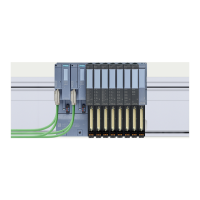Open User Communication
6.11 Secure Open User Communication
Communication
110 Function Manual, 11/2019, A5E03735815-AH
4. Set the parameters for secure communication in the "Start value" column. Enter the
certificate ID of the CA certificate of the communication partner, for example, for
"TLSServerCertRef".
– "ActivateSecureConn": Activation of secure communication for this connection. If this
parameter has the value FALSE, the subsequent security parameters are irrelevant.
You can set up a non-secure TCP or UDP connection in this case.
– "TLSServerCertRef": Reference to the X.509 V3 (CA) certificate of the mail server,
which is used by the TLS client to validate the authentication of the mail server.
5. Create a TMAIL_C instruction in the program editor.
6. Interconnect the MAIL_ADDR_PARAM parameter of the TMAIL_C instruction with the tag
of the data type TMAIL_V4_SEC.
In the following example the MAIL_ADDR_PARAM parameter of the TMAIL_C instruction
is interconnected with the tag "MailConnectionSEC" (data type TMAIL_V4_SEC).
Figure 6-27 TMAIL_C instruction
Setting up a secure connection to a mail server over the interface of a communication module
For secure communication to a mail server over a communication module, you need to
create a data block with one of the system data types TMAIL_V4_SEC, TMAIL_QDN_SEC or
TMAIL_V6_SEC yourself, assign parameters and call it directly at the TMAIL_C instruction.
Requirements:
● TMAIL_C instruction with version V4.0
● S7-1500 CPU as of firmware version V2.0 with communication module CP 1543-1 as of
firmware version V2.0
● ET 200SP CPU as of firmware version V2.0 with communication module CP 1542SP-1
(IRC) as of firmware version V1.0
● You have assigned all the CA certificates of the mail server (TLS server) to the CP
(TLS client) and have downloaded the configuration to the CPU.
● Current date and time are set in the CPU.
The STEP 7 online help describes how to set up a secure connection to a mail server over
the interface of a communication module.

